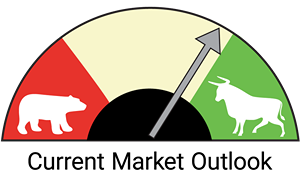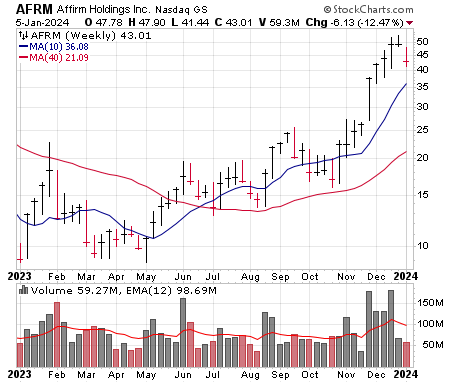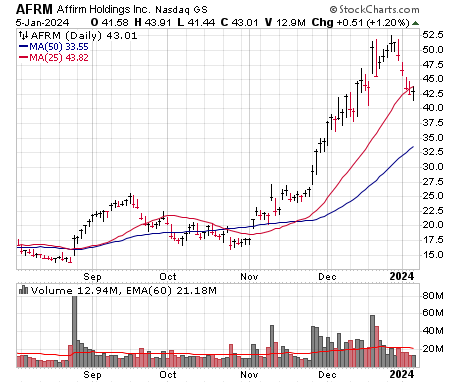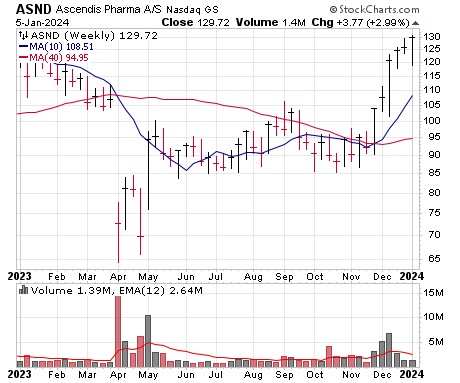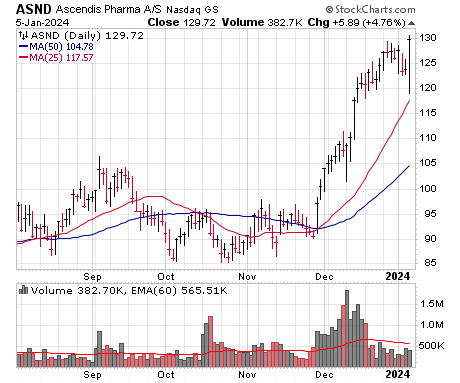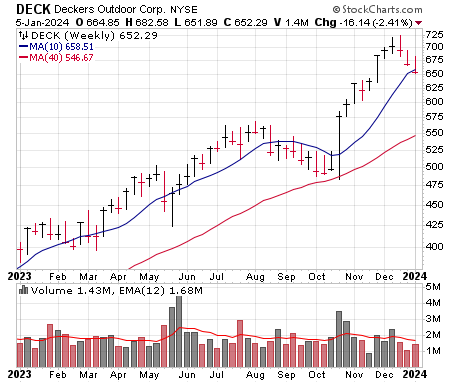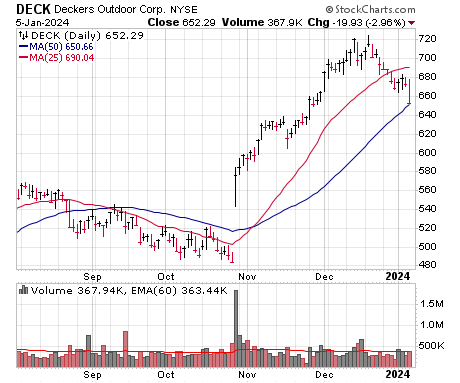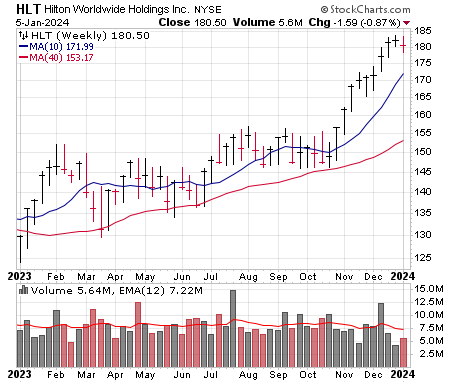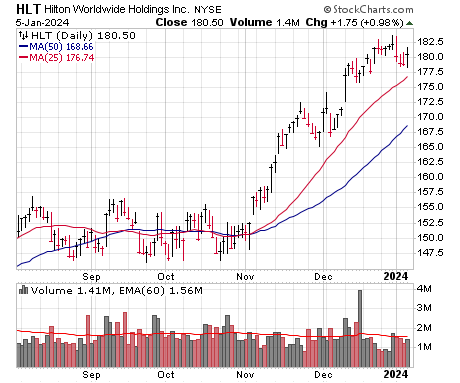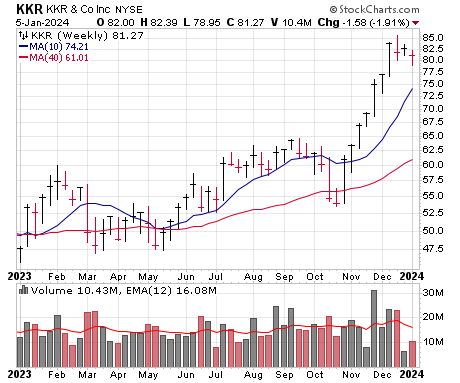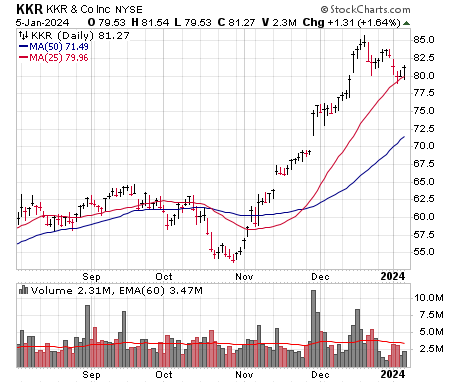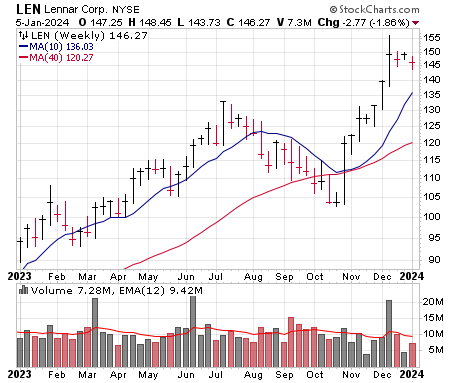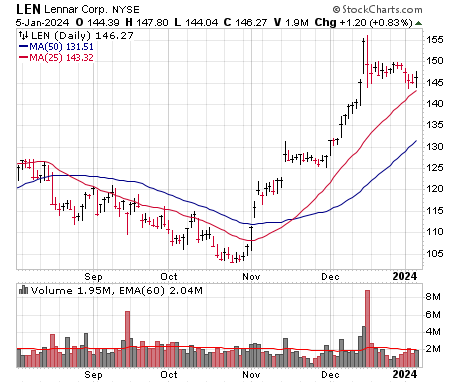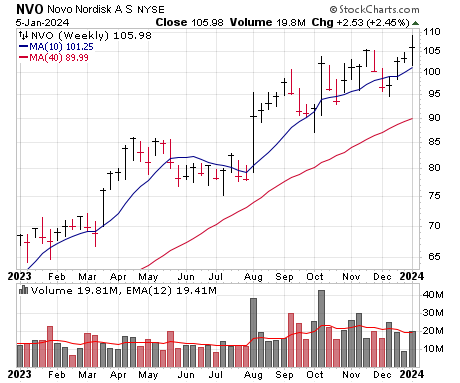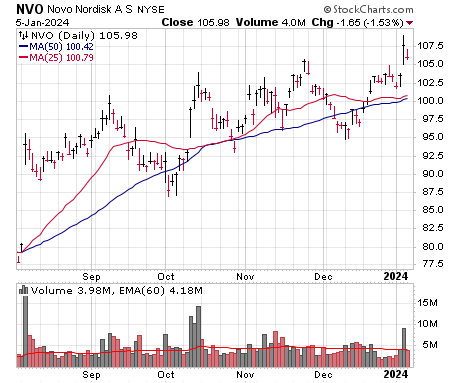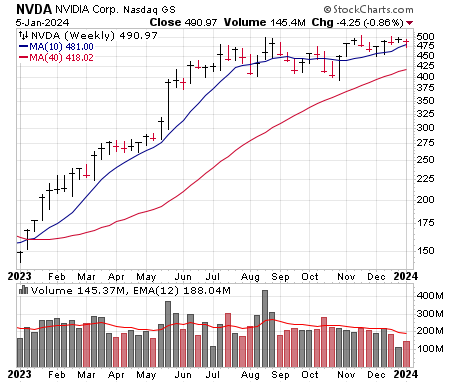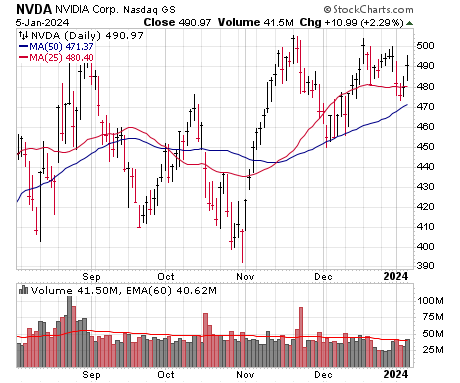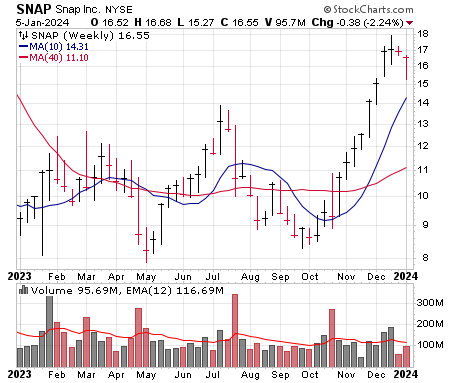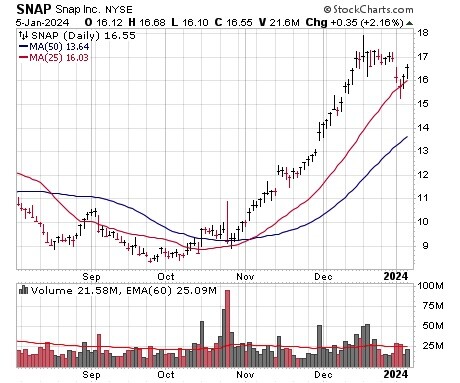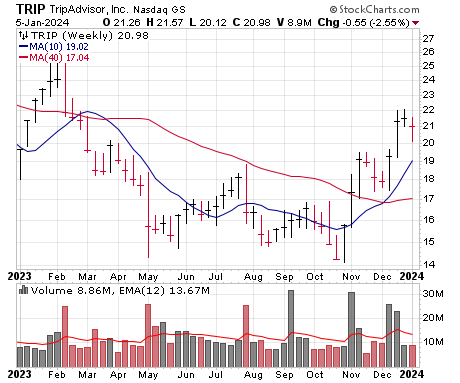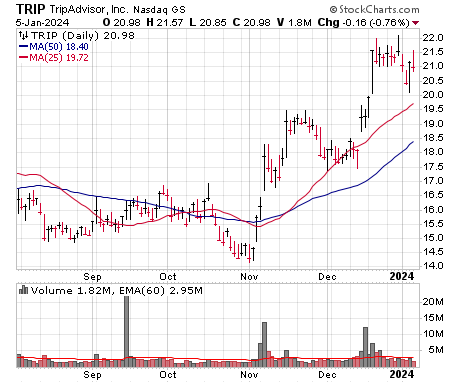Lots of Crosscurrents, but Little Abnormal Action
Not to repeat ourselves, but early January is known for sharp moves, reversals, and reversals of those reversals, and that might be playing out now, with a strong rebound in last week’s losers (which, before last week, were the market’s main winners) today. We’re not ignoring the short-term gyrations, especially if a stock really cracks key support, and, frankly, we’d expect some more tossing and turning given what we’ve seen so far. That said, we advise focusing more on the intermediate term to filter out the noise—and on that front, the vast majority of evidence remains in the bull camp, and many longer-term indications still suggest the market could be just coming out of a two-year funk. We’re going to nudge our Market Monitor down to a level 7 to respect the wobbles we’ve seen (there are far fewer stocks hitting new highs these days, for instance), but overall we’re leaning bullish until the evidence changes.
This week’s list is an interesting one, with a batch of proven performers along with some off-the-bottom and more speculative situations. Our Top Pick is from the latter group: Snap (SNAP) was left for dead during the bear phase but has the makings of a powerful turnaround as revenue growth accelerates from modest levels and some newer offerings take root.
Price |
| Affirm Holdings (AFRM) |
| Ascendis Pharma (ASND) |
| Deckers Outdoors (DECK) |
| Hilton (HLT) |
| KKR (KKR) |
| Lennar (LEN) |
| Novo Nordisk (NVO) |
| Nvidia (NVDA) |
| Snap (SNAP) ★ Top Pick ★ |
| Tripadvisor (TRIP) |
Stock 1
Affirm Holdings (AFRM)
Price |
Why the Strength
Point-of-sale installment loans, known as buy now, pay later (BNPL), are gaining in popularity with U.S. consumers, as nearly one in five Americans took advantage of them in 2023—a lofty 50% increase from the previous year. Even more tellingly, a recent survey revealed that more than half of all consumers want a BNPL option and that 76% would either delay or avoid a retail purchase if it isn’t an option. Affirm is a leader in this space and offers a BNPL service for online and in-store purchases, ranking as the nation’s third-largest BNPL platform behind PayPal Credit and Afterpay; all in all, it boasts over 20% of the total market. Transparency is a key selling point for Affirm, as it shows consumers exactly how much interest they will pay up front, never increasing that amount and never charging any late or hidden fees (indeed, much of Affirm’s income is from merchant service fees rather than interest). Earnings were a big reason for the stock’s strength, with Affirm reporting double-digit improvements in revenue and operating margin in fiscal Q1 (ending September 30) while gaining market share. Total sales jumped 37% from a year ago, while the per-share loss of 57 cents beat estimates by 13 cents. Management said the firm is “firing on all pistons” after “significantly” exceeding its own outlook for revenue less transaction costs. Affirm also just announced new pay-over-time options for self-checkout lanes in nearly 5,000 U.S. Walmart stores (as well as Walmart.com), which comes on the heels of a deal with Google Pay and another with Amazon Business. Plus, Affirm is reportedly exploring a new subscription service that would guarantee a 0% interest rate for installment loans for members who pay a monthly fee. Going forward, the company is nearing sustained profitability on an adjusted income operating basis, while revenues are expected to rise more than 20% this year, which is likely low. Big picture, this is a leading outfit in a sector that has plenty of growth potential.
Technical Analysis
AFRM came public in mid-January 2021 at 90, jumping to 145 a few weeks later, but ultimately crashed into the single digits during the bear market and, even after getting off its knees, hacked around wildly. However, while still super-volatile, the stock’s action from the November low has been very impressive: AFRM rallied nine weeks in a row, including many on huge, above-average weekly volume. It’s an aggressive situation, but if you’re game, we’re not opposed to a small buy here.
| Market Cap | $13.2B | EPS $ Annual (Jun) | ||
| Forward P/E | N/A | FY 2022 | -2.51 | |
| Current P/E | N/A | FY 2023 | -3.34 | |
| Annual Revenue | $1.72B | FY 2024e | -2.70 | |
| Profit Margin | N/A | FY 2025e | -2.11 | |
| Qtrly Rev | Qtrly Rev Growth | Qtrly EPS | Qtrly EPS Growth | |
| ($M) | (vs. yr-ago-qtr) | ($) | (vs. yr-ago-qtr) | |
| Latest qtr | 497 | 37% | -0.57 | N/A |
| One qtr ago | 446 | 22% | -0.69 | N/A |
| Two qtrs ago | 381 | 7% | -0.69 | N/A |
| Three qtrs ago | 400 | 11% | -1.10 | N/A |
Weekly Chart | Daily Chart |
Stock 2
Ascendis Pharma (ASND)
Price |
Why the Strength
Denmark-based Ascendis is a biopharma company focused on developing therapies for rare endocrinology disorders and cancers. The company’s top-selling drug is Skytrofa (lonapegsomatropin), a human growth hormone used for the treatment of growth hormone deficiency (GHD), and it’s also the leading growth hormone product in the U.S. by dollar value. However, Ascendis’ market share of treated U.S. pediatric GHD patients is under 10%, and with pediatric GHD accounting for nearly half of the total growth hormone market, analysts see plenty of additional growth potential just in the U.S. Even better, last month, Ascendis announced positive top-line results for a Phase III trial for Skytrofa in adults with GHD, which demonstrated a statistically significant reduction from baseline in trunk fat and an increase in total body lean mass compared to a placebo. (The results are expected to give Ascendis its first label expansion opportunity for this product.) Further, the firm has announced plans to launch Skytrofa in several European markets this year, having just completed a launch of the product in Germany. Also making headlines recently is Yorvipath (palopegteriparatide), a hormone replacement therapy for the treatment of chronic hypoparathyroidism, or hypoPT; in November, the company announced that authorities in Europe have granted a marketing authorization for the drug treating adult hypoPT patients. More recently, Ascendis entered an exclusive license agreement with Teijin Ltd. for the further development and commercialization of three of its endocrinology treatments in Japan (a key reason for the stock’s strength). In Q3, revenue of $51 million increased 240% year-on-year, and while earnings are deep in the red, the top brass believes it’s on track to become profitable by 2025, led by growth in its endocrinology rare disease pipeline.
Technical Analysis
ASND hit a multi-year low at 65 last April in the wake of a new drug application rejection from the FDA. The market quickly reassessed the situation, however, and the stock bounced back to within 10% of the pre-selloff price a few weeks later. Shares spent an additional six months tightening up in a lateral range, with December marking the change in character—ASND has now advanced six weeks in a row, with the initial move coming on big volume. We’ll set our buy range down from here following the last two big up days, thinking normal volatility will allow a better entry point.
| Market Cap | $7.30B | EPS $ Annual (Dec) | ||
| Forward P/E | N/A | FY 2021 | 3.05 | |
| Current P/E | N/A | FY 2022 | 2.38 | |
| Annual Revenue | $163M | FY 2023e | 3.13 | |
| Profit Margin | N/A | FY 2024e | 3.31 | |
| Qtrly Rev | Qtrly Rev Growth | Qtrly EPS | Qtrly EPS Growth | |
| ($M) | (vs. yr-ago-qtr) | ($) | (vs. yr-ago-qtr) | |
| Latest qtr | 50.8 | 239% | -3.04 | N/A |
| One qtr ago | 51.7 | 701% | -2.36 | N/A |
| Two qtrs ago | 36.4 | 382% | -2.15 | N/A |
| Three qtrs ago | 24.5 | 340% | -3.96 | N/A |
Weekly Chart | Daily Chart |
Stock 3
Deckers Outdoors (DECK)
Price |
Why the Strength
Deckers is known for its premium footwear, including the iconic Ugg brand of fuzzy boots and slippers, as well as the trendy Hoka brand of running shoes. The latter category is generating much of the buzz, as the market for women’s running shoes has grown 28% since pre-pandemic 2019, versus “only” 17% for men’s shoes. Adding to the allure is the fact that Hoka has built a growing following thanks to its eye-catching styling and curved “meta-rocker” sole designed to propel the wearer forward comfortably (its celebrity proponents include Jennifer Garner, Gisele Bündchen and Cameron Diaz); it was also just named one of the top women’s running shoes by Runner’s World magazine. Although Ugg remains Deckers’ biggest brand and accounts for more than half of revenue, the Hoka brand is becoming a big growth driver and is rapidly catching up to Ugg, accounting for 39% of the most recent quarter’s revenues. Hoka sales soared 27% year-on-year in fiscal Q2 (ending September 30), to $424 million (though Ugg was also up 28%), with demand for Hoka seen across all of Deckers’ key international regions and led by a 54% increase in direct-to-consumer sales (which made up 38% of total revenue, compared to 31% last year). The company also experienced record growth across its entire portfolio in the first half of the 2024 fiscal year (up 19%) and expects full-year Hoka growth above 20%, with Ugg growth in the mid-to-single digits. Moreover, Deckers was recently highlighted as an increasingly important competitor for running shoe juggernaut Nike; in fact, an institutional analyst blamed the latter’s disappointing Q2 earnings report on Deckers’ eye-catching market share growth. Wall Street sees steady bottom-line improvement going forward, and the firm regularly tops estimates.
Technical Analysis
After starting a solid uptrend in June, DECK soared nearly 100 points in just over two months before encountering resistance at 565 in August. A multi-week pullback followed, with shares finding support at the 40-week line in late October. Earnings were the catalyst for the big-volume moonshot later that month that pushed DECK to new highs into December. The stock has since pulled back to the 50-day line and then bounced today—it’s normal action thus far, and a further rally would signal the pullback is over. We’ll set our buy range up from here.
| Market Cap | &17.1B | EPS $ Annual (Mar) | ||
| Forward P/E | 28 | FY 2022 | 16.26 | |
| Current P/E | 29 | FY 2023 | 19.37 | |
| Annual Revenue | $3.91B | FY 2024e | 23.87 | |
| Profit Margin | 21.5% | FY 2025e | 27.29 | |
| Qtrly Rev | Qtrly Rev Growth | Qtrly EPS | Qtrly EPS Growth | |
| ($B) | (vs. yr-ago-qtr) | ($) | (vs. yr-ago-qtr) | |
| Latest qtr | 1.09 | 25% | 6.82 | 79% |
| One qtr ago | 0.68 | 10% | 2.41 | 45% |
| Two qtrs ago | 0.79 | 8% | 3.46 | 38% |
| Three qtrs ago | 1.35 | 13% | 10.48 | 24% |
Weekly Chart | Daily Chart |
Stock 4
Hilton (HLT)
Price |
Why the Strength
For many quarters now, the U.S. has seen a big travel boom, with sales, earnings and cash flow increasing for just about all the major players, but the stocks were mostly stuck in the mud—until recently, as big investors are now thinking the boom could continue as the Fed is getting off the economy’s back. Hilton is one of the big hotel chains, and it’s obviously not changing the world—but it is showing growth via both expansion and pricing, has bright prospects and management has proven to be shareholder-friendly. In Q3, the firm continued to crank out solid results, with both sales and EBITDA up mid-teens from the year before, while the company’s overall footprint grew another 14,300 rooms—that was up about 4% and, when results are reported February 14, should see room growth of around 5% for the full year. (The total development pipeline is 457,000 rooms, up 10% from a year ago, so there’s plenty more growth ahead.) As the post-pandemic effect fades, revenue-per-room growth is slowing, but it remains healthy (up 6.8% in Q3) and there’s no reason to think 2024 won’t keep the arrow pointed up in that key metric as some surveys find people expect to travel more in 2024 than last year. Finally, there’s the share buyback program, which is very encouraging—the share count in Q3 was down 4.7% from a year ago and nearly 7% from two years ago, and early December saw the buyback authorization bumped up another $3 billion. (The 2023 return of capital should be $2.5 billion, and we’d expect something similar, if not larger, in 2024.) In sum, there’s nothing revolutionary here, but it looks like investor perception is on the upswing as results should continue to crank ahead.
Technical Analysis
HLT isn’t a typical Top Ten stock, as big hotel stocks are usually pretty sleepy—but, chart-wise, the stock certainly looks to be in the early stages of a new, possibly longer-term move. Impressively, shares didn’t peak until mid-2022, but then retreated and built a long, ever-tightening launching pad for 18 months. The breakout came in November and resulted in a smooth run above 180, with the latest little dip being very well controlled and coming on light volume. You can grab some here with a stop in the mid-160s.
| Market Cap | $46.4B | EPS $ Annual (Dec) | ||
| Forward P/E | 26 | FY 2021 | 2.08 | |
| Current P/E | 29 | FY 2022 | 4.89 | |
| Annual Revenue | $10.1B | FY 2023e | 6.10 | |
| Profit Margin | 23.5% | FY 2024e | 7.05 | |
| Qtrly Rev | Qtrly Rev Growth | Qtrly EPS | Qtrly EPS Growth | |
| ($B) | (vs. yr-ago-qtr) | ($) | (vs. yr-ago-qtr) | |
| Latest qtr | 2.67 | 13% | 1.67 | 27% |
| One qtr ago | 2.66 | 19% | 1.63 | 26% |
| Two qtrs ago | 2.29 | 33% | 1.24 | 75% |
| Three qtrs ago | 2.44 | 33% | 1.59 | 121% |
Weekly Chart | Daily Chart |
Stock 5
KKR (KKR)
Price |
Why the Strength
Maybe the market’s dip last week is the start of yet another rug pull that leads to a big move lower, something we’ve seen a bunch over the past two years—but we always go with the evidence, and right now, the vast majority of intermediate-term (for nearly everything) and even longer-term evidence (for stocks at least) looks good. That’s the main reason to own KKR and other Bull Market stocks, whose earnings and cash flow are tied to asset prices (which have already been picking up) and money flows (which should follow suit as sentiment improves): The firm has just over half a trillion dollars of assets, with big operations in credit ($229 billion), private equity ($174 billion) and real assets ($125 billion), as well as a burgeoning insurance-related business. That said, assets were up just 6% in Q3 from a year ago while inflows were weak as most investors hunkered down in safer assets and expected drier times. However, that should change as markets improve, and a big story here is that the insurance segment is getting a boost: In November, KKR bought the 37% of insurance outfit Global Atlantic it didn’t already own for $2.7 billion, which will boost profits, recurring income and visibility—management believes the transaction will boost distributable earnings by 10% per share this year, and it also lifted its 2026 target for fee-related earnings to $4.50 per share (up from what should be $3.30 per share or so in 2023). Business and the stock will be subject to ups and downs with the market, but after a couple of slow years, we think brighter times are ahead for KKR, and the move into steadier fee-related earnings should keep big investors interested.
Technical Analysis
We’re looking for stocks that had big, persistent runs in November and December, preferably moving to (or close to) new highs, and have since cooled off in a reasonable way. And that’s exactly what we see with KKR, which was the strongest Bull Market stock out of the gate in November (bolstered by the Global Atlantic transaction), lifting seven weeks in a row (including some big-volume buying weeks), followed by a relatively tame three-week retreat to the 25-day line. We’re not ruling out a bit more weakness, but we’re OK starting a position here or (preferably) on dips of another point or two.
| Market Cap | $71.8B | EPS $ Annual (Dec) | ||
| Forward P/E | 17 | FY 2021 | 7.37 | |
| Current P/E | 42 | FY 2022 | -1.06 | |
| Annual Revenue | $12.6B | FY 2023e | 3.40 | |
| Profit Margin | N/M | FY 2024e | 4.87 | |
| Qtrly Rev | Qtrly Rev Growth | Qtrly EPS | Qtrly EPS Growth | |
| ($B) | (vs. yr-ago-qtr) | ($) | (vs. yr-ago-qtr) | |
| Latest qtr | 3.32 | 79% | 0.53 | N/A |
| One qtr ago | 3.63 | 999% | 0.94 | N/A |
| Two qtrs ago | 3.13 | 213% | 0.36 | N/A |
| Three qtrs ago | 2.53 | -38% | 0.09 | -89% |
Weekly Chart | Daily Chart |
Stock 6
Lennar (LEN)
Price |
Why the Strength
Just about everything that was very strong and extended heading into the New Year hit a pothole last week, and that goes for bonds as well, with the 10-year Treasury yield backing up a quarter point from its lows before pulling lower today. Despite that (and despite being overextended as well), homebuilders remain in great shape, and Lennar not only looks to be near a solid entry point but has a better growth outlook than most peers. The firm is the second largest U.S. builder by revenue and market cap (behind just D.R. Horton), and interestingly, it’s used the rough times in the industry to improve its position—it actually saw home sales up 10% for its 2023 fiscal year (ended in November) despite the industry-wide supply shortage, and expects another 10% bump this fiscal year, taking share in most of its markets while weaker players walked away. That’s partly because of the firm’s bolstered financial position (assets are about three times liabilities here, with very little debt), with the top brass saying it’s ready to grab land in areas where others have left. Also intriguing here is Lennar’s dynamic pricing model, which is based on a lot of inputs and has been refined—and should allow them to quickly boost margins if/when the environment improves as the Fed is likely shifting from foe to friend. As for the numbers, sales and earnings turned up in fiscal Q4, and the future looks bright, with the quarter’s new starts lifting a huge 43% from a year ago (which, admittedly, was a rough period), while new orders in units lifted 32%. Throw in a solid share buyback program (share count down nearly 3% from a year ago, and the top brass said it expects to buy back at least $2 billion of shares this year; 4.7% of the current market cap) and analysts see Lennar’s already large bottom line growing double digits in fiscal 2024—and we think even that will prove conservative.
Technical Analysis
After hitting new highs last July, LEN retreated 23% during the market’s correction, but it was then shot out of a cannon in November, running to higher highs as it rose eight weeks in a row through mid-December. And now we see the stock trading very calmly and on very light volume the past three weeks, digesting its big move following a wobble on earnings as the 25-day line has caught up. We’re OK grabbing some here with a stop in the low 130s.
| Market Cap | $41.9B | EPS $ Annual (Nov) | ||
| Forward P/E | 10 | FY 2022 | 17.91 | |
| Current P/E | 10 | FY 2023 | 14.18 | |
| Annual Revenue | $34.0B | FY 2024e | 14.50 | |
| Profit Margin | 15.4% | FY 2025e | 16.16 | |
| Qtrly Rev | Qtrly Rev Growth | Qtrly EPS | Qtrly EPS Growth | |
| ($B) | (vs. yr-ago-qtr) | ($) | (vs. yr-ago-qtr) | |
| Latest qtr | 11.0 | 8% | 5.17 | 3% |
| One qtr ago | 8.7 | -2% | 3.91 | -25% |
| Two qtrs ago | 8.0 | -4% | 2.94 | -37% |
| Three qtrs ago | 6.5 | 5% | 2.12 | -21% |
Weekly Chart | Daily Chart |
Stock 7
Novo Nordisk (NVO)
Price |
Why the Strength
The exploding weight-loss market is thanks in part to the breakthrough treatment from Danish pharma giant Novo Nordisk. Semaglutide, its GLP-1 hormone-mimicking drug marketed under various names including Wegovy (weight loss) and Ozempic (diabetes), has helped to create multi-billion-dollar markets in those two huge end markets. While the company isn’t the only one with a GLP-1 drug now (a competitor from Eli Lilly was greenlit in the U.S. in November), Novo Nordisk is obviously one of the big players. For 2023, currency-neutral sales are expected to have risen 35% to about $33.3 billion, while operating profit likely rose 45%. The boom in semaglutide has Novo Nordisk awash in cash too (north of $10 billion cash flow expected for all of the year), which bodes well for the company being able to fund new applications of its drugs. Management is pursuing new formulations of semaglutide for expanded diabetes and obesity treatments, as well as for promising combination therapies that may address Alzheimer’s and non-alcoholic steatohepatitis. For instance, Wegovy, currently used as a weekly injection, is also showing effective in trials in pill form. The biggest problem for Novo Nordisk lately is simply being able to meet semaglutide demand: About 40% of Americans are obese, leading physicians to throttle back prescriptions to ensure those needing it most (especially diabetes patients) have ample supply. That will tamp growth near term, but analysts still see sales rising 21% and net income at a slightly faster clip this year (and the firm has a history of topping conservative assumptions). Novo Nordisk isn’t just weight loss – it has a pipeline of blood and heart drugs in trials and has been acquiring other companies to diversify the business into blood pressure and receptor-based therapies. Even so, the stock is very likely to trade based on semaglutide trends, with many thinking it (and competing products like Lilly’s) could be the biggest sellers ever. Earnings are due January 31.
Technical Analysis
NVO’s long-term chart is marked by a steady uptrend with strong buying periods followed by orderly consolidations as business has improved. The stock saw a huge positive reaction to earnings in August, though the action since then has been choppy, with higher highs and higher lows, but not a ton of net progress. That’s not to say the action has been poor, though—in fact, the stock tagged new price highs (the RP line is lagging a bit) last Thursday on good volume. We’re OK with a small buy here, and possibly adding if the buying pressures pick up.
| Market Cap | $475B | EPS $ Annual (Dec) | ||
| Forward P/E | 40 | FY 2021 | 1.59 | |
| Current P/E | 45 | FY 2022 | 1.76 | |
| Annual Revenue | $31.0B | FY 2023e | 2.65 | |
| Profit Margin | 47.8% | FY 2024e | 3.18 | |
| Qtrly Rev | Qtrly Rev Growth | Qtrly EPS | Qtrly EPS Growth | |
| ($B) | (vs. yr-ago-qtr) | ($) | (vs. yr-ago-qtr) | |
| Latest qtr | 8.33 | 39% | 0.71 | 69% |
| One qtr ago | 7.96 | 37% | 0.63 | 54% |
| Two qtrs ago | 7.77 | 24% | 0.64 | 39% |
| Three qtrs ago | 6.92 | 18% | 0.43 | 19% |
Weekly Chart | Daily Chart |
Stock 8
Nvidia (NVDA)
Price |
Why the Strength
Chip giant Nvidia became the world’s most profitable semiconductor company in Q3, surpassing leading peers including Intel, Samsung and Taiwan Semi—a feat made possible in large part by its growing artificial intelligence footprint. Indeed, the company turned heads when it announced quarterly revenue of $18 billion, which was more than triple last year’s level, while earnings of $4.02 beat estimates by 19%. The stellar results were led by record data center sales of $14.5 billion, up 280% (and 41% higher from the prior quarter!), with gaming revenue improving 80% (up 15% sequentially). However, the company is placing a lot of its chips (pun intended) on the generative AI (GenAI) trend, which it sees fueling “strong broad-based demand” for its computing solutions. Management noted that most major Internet and cloud companies are “racing” to ramp up GenAI deployment, and it believes the enterprise wave of AI adoption is just beginning. Nvidia also just expanded a collaboration with Microsoft and introduced an AI foundry service for supercharging the development of custom generative AI enterprise applications running on Azure for enterprises and startups. And on the autonomous vehicle (AV) front, Tesla just revealed a $300 million AI cluster armed with an array of 10,000 of Nvidia’s H100 graphics processing units; Nvidia sees a big opportunity in the AV area, and to that end, its DRIVE and Omniverse platforms help train AI algorithms to design the hardware used by car makers to facilitate AV capabilities. (Mercedes-Benz is among the major automakers using Nvidia’s AI-enabled Omniverse to enable its just-released automated driving feature.) An additional likely tailwind for Nvidia going forward is the PC market, which management sees recovering in 2024—and with GenAI serving as the “new pillar app” for high-performance PCs. The bottom line here is that Nvidia has its hands in a ton of huge-growth areas. Analysts see earnings up nearly 70% this year.
Technical Analysis
NVDA showed great volume accumulation early last year and then boomed after earnings near Memorial Day, eventually making its way up to 500 in the summer. Since then, the stock has been consolidating—some see it as lagging, and while technically accurate, NVDA’s four-month rest in the 400 to 500 area (and recently, in the 450 to 500 range) looks normal given the prior huge run—and today shares popped to new price highs on good volume. To be fair, the RP line is still a bit shy of its summer highs, but we like the overall action: We’re OK with a small buy here and potentially adding more on further strength.
| Market Cap | $1.22T | EPS $ Annual (Jan) | ||
| Forward P/E | 26 | FY 2022 | 4.44 | |
| Current P/E | 55 | FY 2023 | 3.34 | |
| Annual Revenue | $44.8B | FY 2024e | 11.37 | |
| Profit Margin | 64.8% | FY 2025e | 19.21 | |
| Qtrly Rev | Qtrly Rev Growth | Qtrly EPS | Qtrly EPS Growth | |
| ($B) | (vs. yr-ago-qtr) | ($) | (vs. yr-ago-qtr) | |
| Latest qtr | 18.1 | 206% | 4.02 | 593% |
| One qtr ago | 13.5 | 101% | 2.70 | 429% |
| Two qtrs ago | 7.19 | -13% | 1.09 | -20% |
| Three qtrs ago | 6.05 | -21% | 0.88 | -33% |
Weekly Chart | Daily Chart |
Stock 9
Snap (SNAP) ★ Top Pick ★
Price |
Why the Strength
Snap’s flagship product is Snapchat, a camera-centric app for sending messages and posting to social media. The company enjoyed a modest revenue rebound in the latter half of 2023 after sequential declines the first part of the year due to the digital ad recession and the loss of many content creators after Snap dropped a revenue-sharing program in 2022; Q3 sales ticked 5% higher and Q4 is estimated to be up about the same, though on the flip side, monthly active users are growing faster, rising about 12% to 750 million. While there’s a sense Snap could have done better last year given the upheaval at Twitter and the concerns around TikTok’s Chinese ownership, the company has some strengths that could get the key revenue-per-user metric rising again. Mainly, it’s the estimate that 90% of 13-to-24-year-olds, and three-quarters of the 13-to-34 crowd, in 20 countries use Snapchat at least once a month, a demographic many marketers want to reach, which means demand should have a high floor. Even with that large young user base, there is runway to get more people using Snapchat since that young demographic represents at most 20% of all mobile phones in any market. Overall, the big attraction (prompting upgrades from a couple of analysts recently) is expectations that the digital ad market will rebound nicely this year, helping to drive slightly accelerating revenue growth in the quarters to come (up 13% for 2024 as a whole). That said, there’s also a nascent subscription angle here as well, with its Snapchat+ offering ($4 per month or $30 per year) providing frequent users a bunch of added features and already having north of seven million sign-ups. Longer term, CEO and founder Evan Spiegel believes the camera will be the easiest gateway to Internet searches and communication between families and friends, given its ease of use compared to text. Even with hiccups, the business is profitable, and given the stock action, it’s a good bet that this year’s 16 cent per share earnings estimate will be conservative.
Technical Analysis
SNAP spent two years in the wilderness, tumbling from its peak of 83 in October 2021 to a low under 8 in late 2022—and then gyrating up and down for another year, with shares still trading near 8 in October. But following an ugly reversal on earnings, shares not only got going, but acted beautifully from November through mid-December, with an accelerating uptrend to nearly 18 before the recent wobbles. We do think SNAP could have a bit more of a rest, so use a loose leash and/or try to buy on dips.
| Market Cap | $27.4B | EPS $ Annual (Dec) | ||
| Forward P/E | 104 | FY 2021 | 0.50 | |
| Current P/E | 108 | FY 2022 | 0.17 | |
| Annual Revenue | $4.55B | FY 2023e | 0.08 | |
| Profit Margin | 2.5% | FY 2024e | 0.16 | |
| Qtrly Rev | Qtrly Rev Growth | Qtrly EPS | Qtrly EPS Growth | |
| ($B) | (vs. yr-ago-qtr) | ($) | (vs. yr-ago-qtr) | |
| Latest qtr | 1.19 | 5% | 0.02 | -75% |
| One qtr ago | 1.07 | -4% | -0.02 | N/A |
| Two qtrs ago | 0.99 | -7% | 0.01 | N/A |
| Three qtrs ago | 1.30 | 0% | 0.14 | -36% |
Weekly Chart | Daily Chart |
Stock 10
Tripadvisor (TRIP)
Price |
Why the Strength
Even after last year’s surge in tourism and travel spending, experts are predicting yet another boom year ahead for air travel. A recent industry survey found that airline passenger traffic will reach nearly five billion this year—4% above pre-pandemic 2019 levels—with 44% saying they will travel more in 2024 than they did last year. These trends favor TripAdvisor, which operates several travel-related websites and mobile apps that are popular for research and bookings for transportation, lodging and dining, attracting over 460 million online visitors each month. However, it’s the company’s subsidiary, Viator, that has taken center stage of late. Viator is billed as the world’s largest online marketplace for tours, attractions and experiences, and it’s clearly benefiting from surging pent-up demand in the wake of the stay-at-home pandemic era. In Q3, Viator reported revenue of $245 million, which increased 41% from the year-ago quarter and made up nearly half of total revenues. The firm sees Viator as a “large” opportunity and the centerpiece of its expansion strategy in the experiences category, and on that score, a major Wall Street bank recently initiated coverage of Tripadvisor with a “buy” rating, pegging Viator’s surge as a “compelling” reason to expect future growth for the company. Beyond the core business, there’s also TheFork, a restaurant reservation platform, which is small ($42 million in revenue) but growing faster than the traditional business (up 20% in the latest quarter). Stepping back, TripAdvisor is also embracing artificial intelligence to improve the customer experience, including a recently launched generative AI-powered itinerary feature, which management sees as a growth drive since members who build an itinerary generate three times higher revenue than the average member. Analysts see mundane top-line growth, though that’s likely conservative.
Technical Analysis
After hitting a multi-year high near 60 in early 2021, TRIP was the dog’s dinner for the next couple of years. However, the selling climaxed last year after falling to a low near 14, with shares spending the last several months rounding out a bottom. The stock finally showed signs of turning the corner in early November, rallying nicely on multiple weeks of big-volume buying. The past two weeks have been choppy, but not abnormal, with shares nosing lower on light volume as the 25-day line catches up. We’re OK grabbing some shares around here.
| Market Cap | $2.90B | EPS $ Annual (Dec) | ||
| Forward P/E | 14 | FY 2021 | -0.30 | |
| Current P/E | 22 | FY 2022 | 0.73 | |
| Annual Revenue | $1.75B | FY 2023e | 1.08 | |
| Profit Margin | 20.1% | FY 2024e | 1.53 | |
| Qtrly Rev | Qtrly Rev Growth | Qtrly EPS | Qtrly EPS Growth | |
| ($M) | (vs. yr-ago-qtr) | ($) | (vs. yr-ago-qtr) | |
| Latest qtr | 533 | 16% | 0.52 | 37% |
| One qtr ago | 494 | 18% | 0.34 | -8% |
| Two qtrs ago | 371 | 42% | 0.05 | N/A |
| Three qtrs ago | 354 | 47% | 0.07 | N/A |
Weekly Chart | Daily Chart |
Previously Recommended Stocks
| Date | Stock | Symbol | Top Pick | Original Buy Range | 1/8/24 |
| HOLD | |||||
| 12/18/23 | 133-137 | 146 | |||
| 12/4/23 | 52.5-54 | 52 | |||
| 10/16/23 | 214-218 | 252 | |||
| 12/18/23 | 47-49 | 47 | |||
| 12/18/23 | 124-127 | 122 | |||
| 9/5/23 | ★ | 161-166 | 261 | ||
| 12/18/23 | 120-124 | 119 | |||
| 12/11/23 | ★ | 45.5-48 | 52 | ||
| 11/6/23 | 86.5-89 | 99 | |||
| 11/6/23 | ★ | 33-35 | 34 | ||
| 11/13/23 | 202-208 | 210 | |||
| 12/4/23 | 106-112 | 109 | |||
| 1/2/24 | 82.5-85.5 | 83 | |||
| 1/2/24 | 21.4-22.4 | 23 | |||
| 1/2/23 | 20-21 | 22 | |||
| 12/11/23 | 58-60.5 | 60 | |||
| 1/2/24 | 67.5-69.5 | 72 | |||
| 11/6/23 | 433-445 | 497 | |||
| 1/2/24 | 80.5-82.5 | 85 | |||
| 1/2/24 | ★ | 127-132 | 134 | ||
| 9/5/23 | ★ | 33-34.5 | 47 | ||
| 2/27/23 | 225-230 | 523 | |||
| 11/6/23 | 29.5-31 | 37 | |||
| 11/20/23 | ★ | 86.5-89 | 104 | ||
| 11/20/23 | 101-104 | 124 | |||
| 12/11/23 | 187-191 | 196 | |||
| 10/30/23 | 166-169 | 197 | |||
| 11/6/23 | 77-79 | 102 | |||
| 5/8/23 | 37-39 | 59 | |||
| 12/11/23 | 22.5-24 | 23 | |||
| 12/4/23 | 505-515 | 552 | |||
| 12/4/23 | ★ | 44-46 | 49 | ||
| 12/4/23 | Workday | WDAY | 257-264 | 273 | |
| WAIT | |||||
| 1/2/24 | 41-43 | 39 | |||
| 11/6/23 | ServiceNow | NOW | 702-712 | 696 | |
| SELL | |||||
| 12/18/23 | Monday.com | 187-193 | 185 | ||
| 12/18/23 | 46-48 | 41 | |||
| 12/4/23 | 31.5-33 | 32 | |||
| 11/20/23 | 47.5-48.5 | 50 | |||
| 10/2/23 | Zscaler | ZS | 165-170 | 218 | |
| DROPPED | |||||
The next Cabot Top Ten Trader issue will be published on January 16, 2024.
